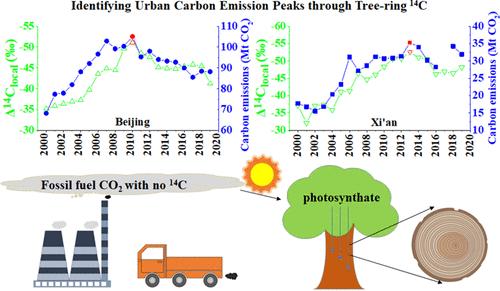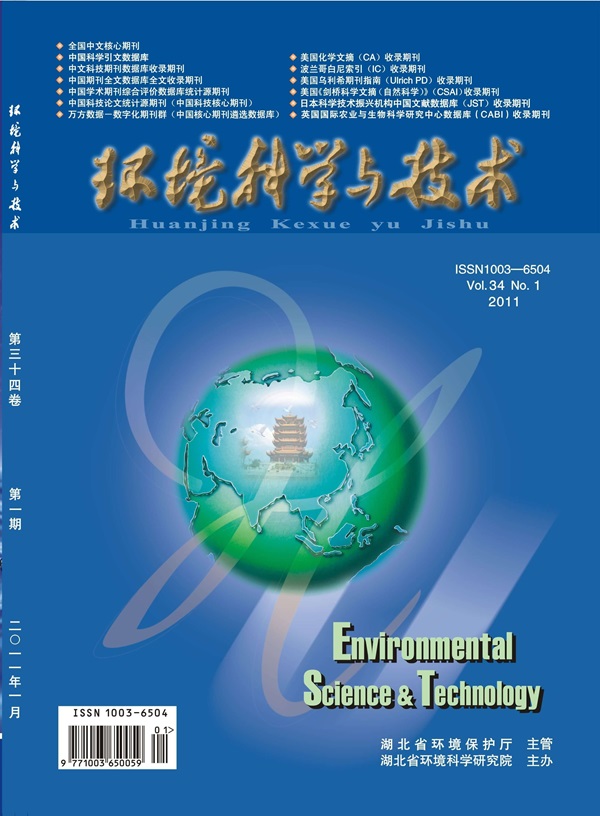Identification of Urban Carbon Emission Peaks through Tree-Ring 14C
IF 11.3
1区 环境科学与生态学
Q1 ENGINEERING, ENVIRONMENTAL
引用次数: 0
Abstract
Independent identification of carbon emission peaks determined from fuel inventories is a challenging goal. Because of the complete depletion of radiocarbon (14C) in fossil fuel sources, the measurement of atmospheric 14CO2 has proven to offer a means of achieving this goal. Here, we present a study identifying peak carbon emissions from two Chinese cities using urban tree-ring Δ14C time series during 2000–2019. After subtracting background atmospheric Δ14C from urban tree-ring Δ14C to isolate local Δ14C (Δ14Clocal), we find a minimum in 2010 (−51.1 ± 4.5‰) in Beijing and in 2013 in Xi’an (−52.5 ± 0.5‰). These levels correspond to an urban carbon emission peak in 2010 and in 2013 in the two respective cities. The urban carbon emission peaks are further identified by the declines of the mean absolute interannual rate of decrease of tree-ring Δ14C during a period, with the respective values of 3.6 and 6.4 ‰/yr after and before a turning point in Beijing and 3.0 and 6.0 ‰/yr after and before a turning point in Xi’an. This study provides an observation method to identify carbon emission peaks in basin cities.

通过树环 14C 确定城市碳排放峰值
独立识别根据燃料清单确定的碳排放峰值是一个具有挑战性的目标。由于化石燃料源中的放射性碳(14C)已完全耗尽,因此测量大气中的 14CO2 已被证明是实现这一目标的一种方法。在此,我们利用 2000-2019 年间的城市树环Δ14C 时间序列,对中国两个城市的碳排放峰值进行了研究。从城市树环Δ14C中减去大气本底Δ14C以分离出本地Δ14C(Δ14Clocal)后,我们发现北京在2010年(-51.1±4.5‰)和西安在2013年(-52.5±0.5‰)出现了最低值。这些水平分别对应着两个城市 2010 年和 2013 年的城市碳排放峰值。城市碳排放峰值还可以通过一个时期内树环比Δ14C年际平均绝对下降率的下降来进一步识别,北京在转折点前后分别为3.6和6.4‰/年,西安在转折点前后分别为3.0和6.0‰/年。这项研究为确定流域城市的碳排放峰值提供了一种观测方法。
本文章由计算机程序翻译,如有差异,请以英文原文为准。
求助全文
约1分钟内获得全文
求助全文
来源期刊

环境科学与技术
环境科学-工程:环境
CiteScore
17.50
自引率
9.60%
发文量
12359
审稿时长
2.8 months
期刊介绍:
Environmental Science & Technology (ES&T) is a co-sponsored academic and technical magazine by the Hubei Provincial Environmental Protection Bureau and the Hubei Provincial Academy of Environmental Sciences.
Environmental Science & Technology (ES&T) holds the status of Chinese core journals, scientific papers source journals of China, Chinese Science Citation Database source journals, and Chinese Academic Journal Comprehensive Evaluation Database source journals. This publication focuses on the academic field of environmental protection, featuring articles related to environmental protection and technical advancements.
 求助内容:
求助内容: 应助结果提醒方式:
应助结果提醒方式:


